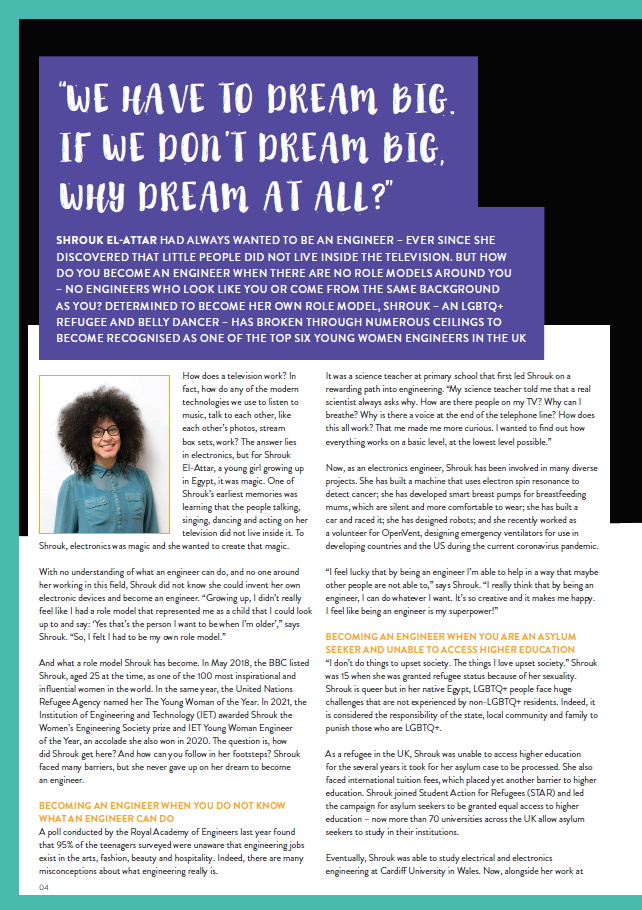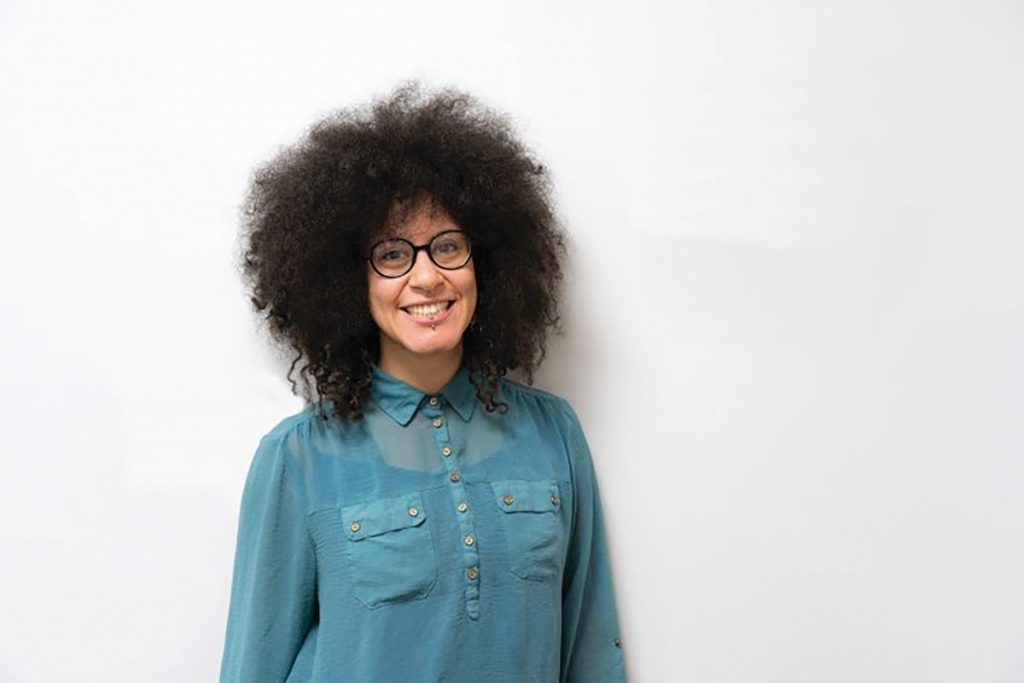“We have to dream big. If we don’t dream big, why dream at all?” – Shrouk El-Attar, IET Young Woman Engineer of the Year
Shrouk El-Attar had always wanted to be an engineer – ever since she discovered that little people did not live inside the television. But how do you become an engineer when there are no role models around you – no engineers who look like you or come from the same background as you? Determined to become her own role model, Shrouk – an LGBTQ+ refugee and belly dancer – has broken through numerous ceilings to become recognised as one of the top six young women engineers in the UK
How does a television work? In fact, how do any of the modern technologies we use to listen to music, talk to each other, like each other’s photos, stream box sets, work? The answer lies in electronics, but for Shrouk El-Attar, a young girl growing up in Egypt, it was magic. One of Shrouk’s earliest memories was learning that the people talking, singing, dancing and acting on her television did not live inside it. To Shrouk, electronics was magic and she wanted to create that magic.
With no understanding of what an engineer can do, and no one around her working in this field, Shrouk did not know she could invent her own electronic devices and become an engineer. “Growing up, I didn’t really feel like I had a role model that represented me as a child that I could look up to and say: ‘Yes that’s the person I want to be when I’m older’,” says Shrouk. “So, I felt I had to be my own role model.”
And what a role model Shrouk has become. In May 2018, the BBC listed Shrouk, aged 25 at the time, as one of the 100 most inspirational and influential women in the world. In the same year, the United Nations Refugee Agency named her The Young Woman of the Year. In 2021, the Institution of Engineering and Technology (IET) awarded Shrouk the Women’s Engineering Society prize and IET Young Woman Engineer of the Year, an accolade she also won in 2020. The question is, how did Shrouk get here? And how can you follow in her footsteps? Shrouk faced many barriers, but she never gave up on her dream to become an engineer.
BECOMING AN ENGINEER WHEN YOU DO NOT KNOW WHAT AN ENGINEER CAN DO
A poll conducted by the Royal Academy of Engineers last year found that 95% of the teenagers surveyed were unaware that engineering jobs exist in the arts, fashion, beauty and hospitality. Indeed, there are many misconceptions about what engineering really is.
It was a science teacher at primary school that first led Shrouk on a rewarding path into engineering. “My science teacher told me that a real scientist always asks why. How are there people on my TV? Why can I breathe? Why is there a voice at the end of the telephone line? How does this all work? That me made me more curious. I wanted to find out how everything works on a basic level, at the lowest level possible.”
“I don’t do things to upset society. The things I love upset society,” says Shrouk.
How does a television work? In fact, how do any of the modern technologies we use to listen to music, talk to each other, like each other’s photos, stream box sets, work? The answer lies in electronics, but for Shrouk El-Attar, a young girl growing up in Egypt, it was magic. One of Shrouk’s earliest memories was learning that the people talking, singing, dancing and acting on her television did not live inside it. To Shrouk, electronics was magic and she wanted to create that magic.
With no understanding of what an engineer can do, and no one around her working in this field, Shrouk did not know she could invent her own electronic devices and become an engineer. “Growing up, I didn’t really feel like I had a role model that represented me as a child that I could look up to and say: ‘Yes that’s the person I want to be when I’m older’,” says Shrouk. “So, I felt I had to be my own role model.”
And what a role model Shrouk has become. In May 2018, the BBC listed Shrouk, aged 25 at the time, as one of the 100 most inspirational and influential women in the world. In the same year, the United Nations Refugee Agency named her The Young Woman of the Year. In 2021, the Institution of Engineering and Technology (IET) awarded Shrouk the Women’s Engineering Society prize and IET Young Woman Engineer of the Year, an accolade she also won in 2020. The question is, how did Shrouk get here? And how can you follow in her footsteps? Shrouk faced many barriers, but she never gave up on her dream to become an engineer.
BECOMING AN ENGINEER WHEN YOU DO NOT KNOW WHAT AN ENGINEER CAN DO
A poll conducted by the Royal Academy of Engineers last year found that 95% of the teenagers surveyed were unaware that engineering jobs exist in the arts, fashion, beauty and hospitality. Indeed, there are many misconceptions about what engineering really is.
It was a science teacher at primary school that first led Shrouk on a rewarding path into engineering. “My science teacher told me that a real scientist always asks why. How are there people on my TV? Why can I breathe? Why is there a voice at the end of the telephone line? How does this all work? That me made me more curious. I wanted to find out how everything works on a basic level, at the lowest level possible.”
Now, as an electronics engineer, Shrouk has been involved in many diverse projects. She has built a machine that uses electron spin resonance to detect cancer; she has developed smart breast pumps for breastfeeding mums, which are silent and more comfortable to wear; she has built a car and raced it; she has designed robots; and she recently worked as a volunteer for OpenVent, designing emergency ventilators for use in developing countries and the US during the current coronavirus pandemic.
“I feel lucky that by being an engineer I’m able to help in a way that maybe other people are not able to,” says Shrouk. “I really think that by being an engineer, I can do whatever I want. It’s so creative and it makes me happy. I feel like being an engineer is my superpower!”
BECOMING AN ENGINEER WHEN YOU ARE AN ASYLUM SEEKER AND UNABLE TO ACCESS HIGHER EDUCATION
“I don’t do things to upset society. The things I love upset society.” Shrouk was 15 when she was granted refugee status because of her sexuality. Shrouk is queer but in her native Egypt, LGBTQ+ people face huge challenges that are not experienced by non-LGBTQ+ residents. Indeed, it is considered the responsibility of the state, local community and family to punish those who are LGBTQ+.
As a refugee in the UK, Shrouk was unable to access higher education for the several years it took for her asylum case to be processed. She also faced international tuition fees, which placed yet another barrier to higher education. Shrouk joined Student Action for Refugees (STAR) and led the campaign for asylum seekers to be granted equal access to higher education – now more than 70 universities across the UK allow asylum seekers to study in their institutions.
Eventually, Shrouk was able to study electrical and electronics engineering at the University of Cardiff in Wales. Now, alongside her work at Elvie, a FemTech company that designs technologies specifically for women, Shrouk campaigns tirelessly for the rights of refugees and LGBTQ+ people.
BECOMING AN ENGINEER WHEN YOU DO NOT HAVE A ROLE MODEL
“If engineering had been introduced to me as ‘engineering’, I might not have been interested because there is this a very specific idea of what an engineer is, which is not true.” Shrouk did not have a role model when she was growing up, but she sees huge value in being able to see yourself reflected in people who make decisions or are in positions of influence.
“Growing up around other people who didn’t feel marginalised or had role models already for them, I could see the difference and how powerful that was for them,” says Shrouk. “So, I’d love to see more role models who can represent more people like me. It’s just as important for boys and young men to look up to us as their role models.”
Despite being an inspiration to many herself, Shrouk now has a role model: Yewande Akinola, a chartered engineer who specialises in sustainable water supplies and was recognised as IET Young Woman Engineer of the Year in 2012 and awarded an MBE for her services to engineering and diversity in STEM design and innovation in 2020. “She’s incredible,” says Shrouk. “I remember finding out about Yewande Akinola a few years ago and realising that she’s a principal engineer, she’s an MBE, she’s presented all these programmes on the Discovery Channel and Channel 4, she’s creative and she’s a dancer like me.”
BECOMING AN ENGINEER WHEN YOU ARE CREATIVE
“I teach English to refugees [in Cardiff]. I belly dance. I draw and play some music. I campaign for refugees’ rights because asylum seekers don’t have [equal] access to higher education.” Shrouk is a creative person, but, unfortunately, education systems around the world tend to divide the population into ‘scientists’ and ‘artists’. You are either one or the other – not both. And yet, the sciences and the arts go hand in hand. According to a blog post written in , “Nobel laureates in the sciences are seventeen times likelier than the average scientist to be a painter, twelve times as likely to be a poet, and four times as likely to be a musician.”
As Shrouk says, “I feel like we are missing out on so much creativity in engineering, and I really just want to know what the world would look like if we told all these creative people that engineering is for them, too. What kind of amazing engineers we would have had by now?”



